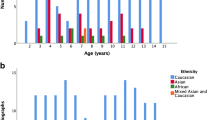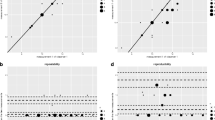Abstract
Background
The applicability today of Greulich and Pyle's Radiographic Atlas of Skeletal Development of the Hand and Wrist (G&P) is uncertain.
Objective
The purpose of this study was to determine whether G&P is accurate in Israeli children today.
Materials and methods
Left-hand radiographs of 679 children (375 boys) ranging in age from 1 day to 18 years old were obtained for trauma in the period 2001–2009 and were evaluated for bone age according to G&P. Individual bone age was plotted against calendar age and smoothed to obtain the association between calendar age and bone age. Any difference was assessed with Wilcoxon signed-rank test.
Results
In girls, there was no significant difference between bone age and calendar age (P = 0.188). G&P underestimated bone age in boys <15 years old (median difference, 2.3 months; P < 0.0001) and overestimated bone age in boys ≥15 years old (median difference, 2.9 months; P = 0.0043). The largest median difference (5.4 months; P = 0.0003) was seen in boys 6–10 years old.
Conclusion
The differences between calendar age and bone age according to G&P were relatively small compared with normal variance and are unlikely to be of clinical importance.



Similar content being viewed by others
References
Greulich WW, Pyle SI (1959) Radiographic atlas of skeletal development of hand and wrist, 2nd edn. Stanford University Press, Stanford
Groell R, Lindbichler F, Riepl T et al (1999) The reliability of bone age determination in central European children using the Greulich and Pyle method. Br J Radiol 72:461–464
Van Rijn RR, Lequin MH, Robben SG et al (2001) Is the Greulich and Pyle atlas still valid for Dutch Caucasian children today? Pediatr Radiol 31:748–752
Loder RT, Estle DT, Morrison K et al (1993) Applicability of the Greulich and Pyle skeletal age standards to black and white children of today. Am J Dis Child 147:1329–1333
Ontell FK, Ivanovic M, Ablin DS et al (1996) Bone age in children of diverse ethnicity. AJR 167:1395–1398
Koc A, Karaoglanoglu M, Erdogan M et al (2001) Assessment of bone ages: Is the Greulich-Pyle method sufficient for Turkish boys? Pediatr Int 43:662–665
Büken B, Safak AA, Yazici B et al (2007) Is the assessment of bone age by the Greulich-Pyle method reliable at forensic age estimation for Turkish children? Forensic Sci Int 173:146–153
Mackay DH (1952) Skeletal maturation in the hand: a study of development in East African children. Trans R Soc Trop Med Hyg 46:135–150
Zhang A, Sayre JW, Vachon L et al (2009) Racial differences in growth patterns of children assessed on the basis of bone age. Radiology 250:228–235
Chaumoître K, Adalian P, Colavolpe N et al (2008) Value of the sesamoid bone of the thumb in the determination of bone age. J Radiol 89:1921–1924
The National Institute of Standards and Technology (NIST) (2010) NIST/SEMATECH e-handbook of Statistical Methods. National Institute of standards and Technology (U.S. Department of Commerce), Gaithersburg. http://www.nist.gov/itl/sed/gsg/handbook_project.cfm. Accessed June 2011
Cattaneo C, Ritz-Timme S, Gabriel P et al (2009) The difficult issue of age assessment on pedo-pornographic material. Forensic Sci Int 183:e21–e24
Buckler JM (1983) How to make the most of bone ages. Arch Dis Child 58:761–763
Mora S, Boechat MI, Pietka E et al (2001) Skeletal age determinations in children of European and African descent: applicability of the Greulich and Pyle standards. Pediatr Res 50:624–628
Zafar AM, Nadeem N, Husen Y et al (2010) An appraisal of Greulich-Pyle Atlas for skeletal age assessment in Pakistan. J Pak Med Assoc 60:552–555
Thodberg HH, Kreiborg S, Juul A, Pedersen KD (2009) The BoneXpert method for automated determination of skeletal maturity. IEEE Trans Med Imaging 28:52–66
Gluckman PD, Hanson MA (2006) Evolution, development and timing of puberty. Trends Endocrinol Metab 17:7–12
Newacheck PW, Taylor WR (1992) Childhood chronic illness: Prevalence, severity and impact. Am J Public Health 82:364–371
Hawley NL, Rousham EK, Norris SA et al (2009) Secular trends in skeletal maturity in South Africa: 1962–2001. Ann Hum Biol 36:584–594
Frisch H, Riedl S, Waldhör T (1996) Computer-aided estimation of skeletal age and comparison with bone age evaluations by the method of Greulich-Pyle and Tanner-Whitehouse. Pediatr Radiol 26:226–231
Cao F, Huang HK, Pietka E et al (2000) Digital hand atlas and web-based bone age assessment: system design and implementation. Comput Med Imaging Graph 24:297–307
Author information
Authors and Affiliations
Corresponding author
Rights and permissions
About this article
Cite this article
Soudack, M., Ben-Shlush, A., Jacobson, J. et al. Bone age in the 21st century: is Greulich and Pyle’s atlas accurate for Israeli children?. Pediatr Radiol 42, 343–348 (2012). https://doi.org/10.1007/s00247-011-2302-1
Received:
Revised:
Accepted:
Published:
Issue Date:
DOI: https://doi.org/10.1007/s00247-011-2302-1




